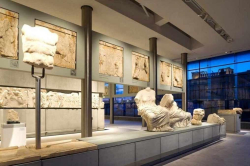Acropolis Museum

Acropolis Museum
In 1863, it was decided to build the museum on an area east of the Acropolis and Parthenon and the grounding was done in 1865. We had to reach the 1970s to realize that the existing museum could not adequately serve the large numbers of visitors. Furthermore, the unsuitability of the space created problems because it downgraded the aesthetic result that the exhibition of the masterpieces was trying to achieve.
In September of 1976, Konstantinos Karamanlis was the first to express the necessity for the creation a new Acropolis Museum, determining the exact boundaries of the area where the new museum was finally built.
According to the vision of the Greek politician, the new museum would possess all of the necessary technical facilities for the conservation of the priceless works of Greek art – where the sculptures of the Parthenon Temple, the Karyatides from the Erechtheio and all the sculptures from the storage area of the old museum would be transferred to. For these reasons, two architectonic contests were conducted in 1976 and 1979, while in 1989 the Minister of Culture, Melina Merkouri, put into motion an international contest – the results of which were canceled because a large residential area was discovered on the Makrygianni land (dated from the Prehistoric Era until the Byzantine times) and it was necessary to include the new museum area in the excavations that had to be ordered.
Finally, in 2000, the Organization of Building the New Acropolis Museum (OANMA) announced the invitation to participate in a new bidding that followed the guidelines of the European Union and awarded the first prize to Bernard Tschumi with Michalis Fotiadis. Finally, the foundations for the new museum were laid in 2003 and the Organization of the Acropolis Museum was established in 2008 with the purpose that the museum would house every object that has been discovered on the sacred rock of the Acropolis and the foot of its hill – covering a vast chronological period from the Mycenaean era to the Roman and the Paleochristian Athens. The building was designed by Bernard Tschumi, with the sole purpose to harmonically combine the light, trend and tectonic programming.
The Acropolis Museum is in its total 25,000 square meters and offers exhibition spaces with an area of 14,000 square meters – which is ten times larger than the old museum, providing all of the services that are required by a modern international museum. The museum's collections are exhibited in three levels, while an additional middle level houses the secondary rooms such as the restaurant, the gift shop and offices. It is worth noting that the exhibition of the Parthenon sculptures has the same facing aspect with the temple on the rock and the usage of glass allows for the natural lighting of the area, while the floor is often transparent (by the usage of glass), inside and outside and allows the visitor to look directly at the excavations of the area.
An amphitheater, a virtual reality theater, a VIP area and a room for special exhibitions are included as benefits of the museum, which are all served by the Acropolis-Station of Line 2 of the Athens Metro.











